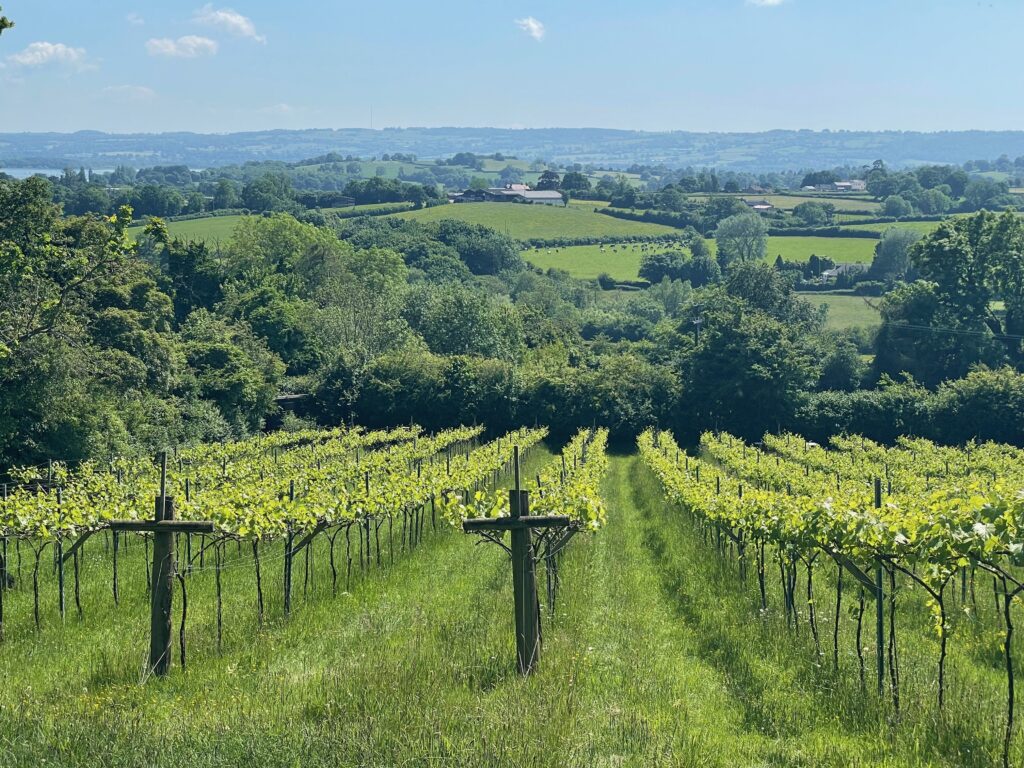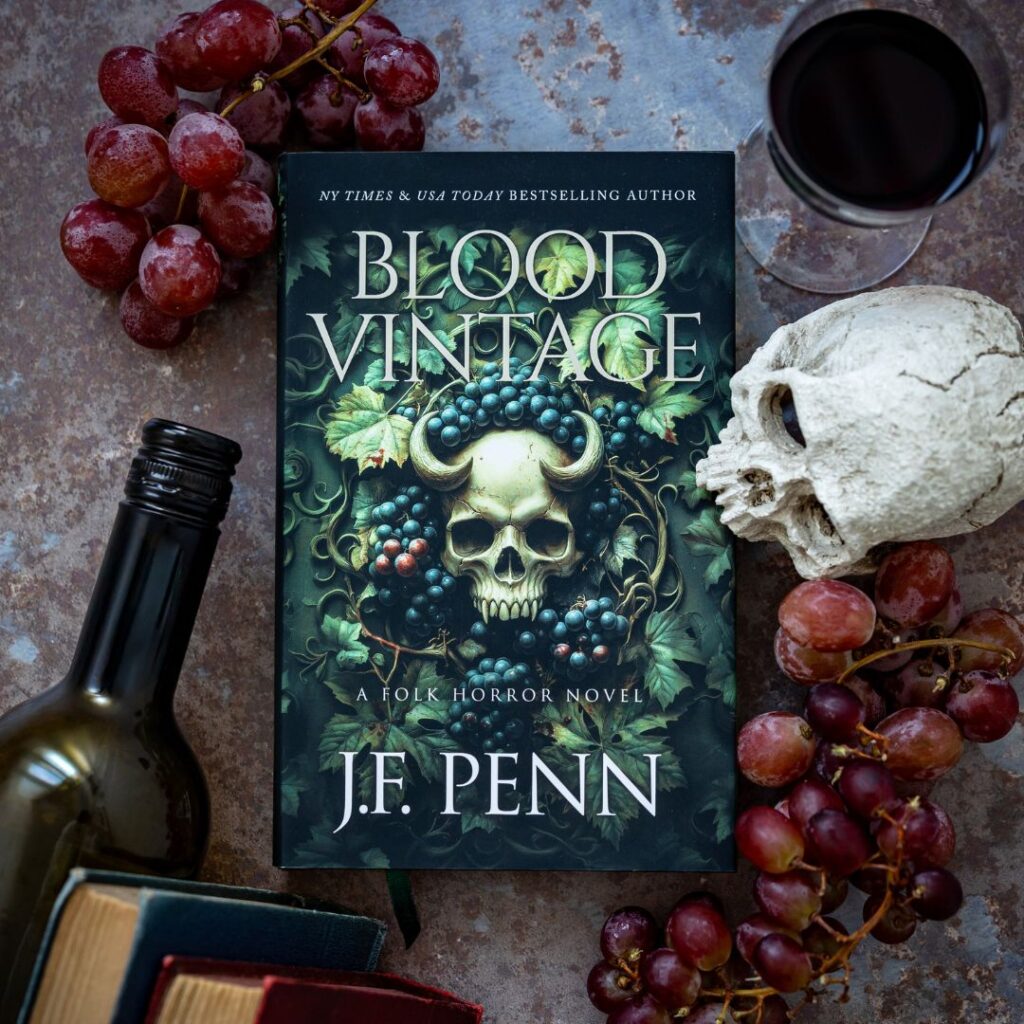How did visiting two English vineyards spark the idea behind Blood Vintage, a Folk Horror novel? J.F. Penn talks to Natalie Maclean on The Unreserved Wine Talk Podcast.
You can listen to the full interview on your favourite podcast app, or here, and you can read the transcript of the full interview here with pictures.
Natalie: Tell us what drew you to this story in the first place. Where did this idea come to you?
Jo: Woodchester Valley is a small vineyard in The Cotswolds, which is in the southwest of England. It’s an Area of Outstanding Natural Beauty. It’s the kind of ‘chocolate box’ England with the green rolling hills —lots of green ’cause it does rain — but it’s also sunny.

There are lots of stone buildings. Cows wandering around. It’s kind of pastoral, but also enough hills.
Woodchester Valley — I went with my dad and my step-mum and my husband drove. It was July, so the grapes were the tiny little green bits. They weren’t full yet. We went there for a wine tour and one of the first things they said was — this area of vines was south facing and it was beautiful.
They told us about the frost candles, the bougies, I think they’re called, where in the winter they put them in amongst the vines to stop the frost and to stop them killing the bud break. And I was like, oh my goodness. In my mind, I could see the frost candles and I had story ideas going off in my brain.
They told us about this ancient part of the vineyard that they own where we couldn’t visit. And I was like, oh, oh, I’ve got to know more about that.
And it turns out, the vineyard owner Fiona found a mention of this area in the Doomsday Book. If you don’t know, it’s an 11th century document that was essentially a tax record so they could tax people on land, and there’s a vineyard in this area from the 11th century.
And so I was like, ‘oh my goodness.’ In my mind I was like, there has to be some ancient ritual in this place. The Romans brought vines here between 43 AD and 400 AD. So 1600, 2000 years ago and in fact, where I live in Bath, it used to be called Aquae Sulis. We have 2000-year-old Roman baths in the center of my city. So the land where I stand and where these vines are and where the book is set, they’re kind of this ancient history that’s now coming back to life, I guess.
Natalie: Absolutely.
You live an hour’s drive away from one of England’s few biodynamic vineyards. Tell us about that.
Jo: Yes, so this is really special.
Limeburn Hill Vineyard, it’s biodynamic and it is certified. This is in the Chew Magna area near me. It’s limestone. The Romans were working in that area. So again, it’s very ancient land. [More photos and details from my visit here.]

It has 3000 vines, hand planted. It’s run by a couple, Robin and Georgina, and I went and spent a day there. I did a course on biodynamic wine growing and it was full of wine people, and then I was like, ‘I’m writing a novel’ and Robin was very patient with me and, and especially when I said, ‘oh, where do you bury the bones?’ He was like, ‘okay, I’ll show you.’
And their wines, they have three wines named after festivals, so Beltane, Lammas and Samhain, these are Celtic festivals. That gave me ideas, but then also they explained what biodynamics is, and the Rudolf Steiner method of really just the holistic view of the vineyard as a contained ecosystem.
They were taking this very, very seriously. So they had wild bees because it’s all the natural yeast in the area. There’s no extra stuff. They have these little sheep that run around eating things.
I was super impressed by, again, how much work this is, but also the ecosystem of the land. It was beautiful. It was so beautiful, a wonderful day. Robin demonstrated the dynamiser, which is a stirring thing where they stir for a minute in one direction and then the other direction.
And he had the books out with all the sun and the moon and the planting and the energies that go into it. And this was all just fascinating to me. That is Limeburn Hill Vineyard and they do tours and courses and things. They’re fascinating — and I should say there was no sacrifice!
Natalie: Yeah, I was gonna say, no blood sacrifice!
Jo: But they did honour the land. They had an area, a sacred grove.

And obviously there is the place where they bury the horns and I mean, there are some preparations with skulls and things, so it’s just some weird stuff going on in biodynamics.
Preparation 500 is the cow horn. Each of these preparations are made from either animal parts, so stomachs, bladders, intestines, skull, and then you fill them with manure or certain plants like yarrow, chamomile, different things, and that should be growing on your land as well, so it’s all a contained ecosystem.
And then you basically bury the horns in the winter and the skulls you put in this wet place like under some running water and then after a certain amount of time you put that in the dynamiser and then you spray it on either the roots or the leaves or whatever you need.
What’s so fascinating is you might think, oh, that is just weird. Like strange, strange stuff. But when you think about the vineyard as an ecosystem and the real terroir, the sense of place that they’re trying to just put into every single drop of the wine, well, why would you bring in something from the outside, right? I just thought that was fascinating because the idea of the land itself is what I’m so fascinated with.
How we feed the land to make the land then feed us, and this is something that just really interests me.
Blood Vintage is out now on Kickstarter: www.JFPenn.com/bloodvintage

The post Where Did The Idea For Blood Vintage Come From? first appeared on The Creative Penn.
Go to Source
Author: Joanna Penn
